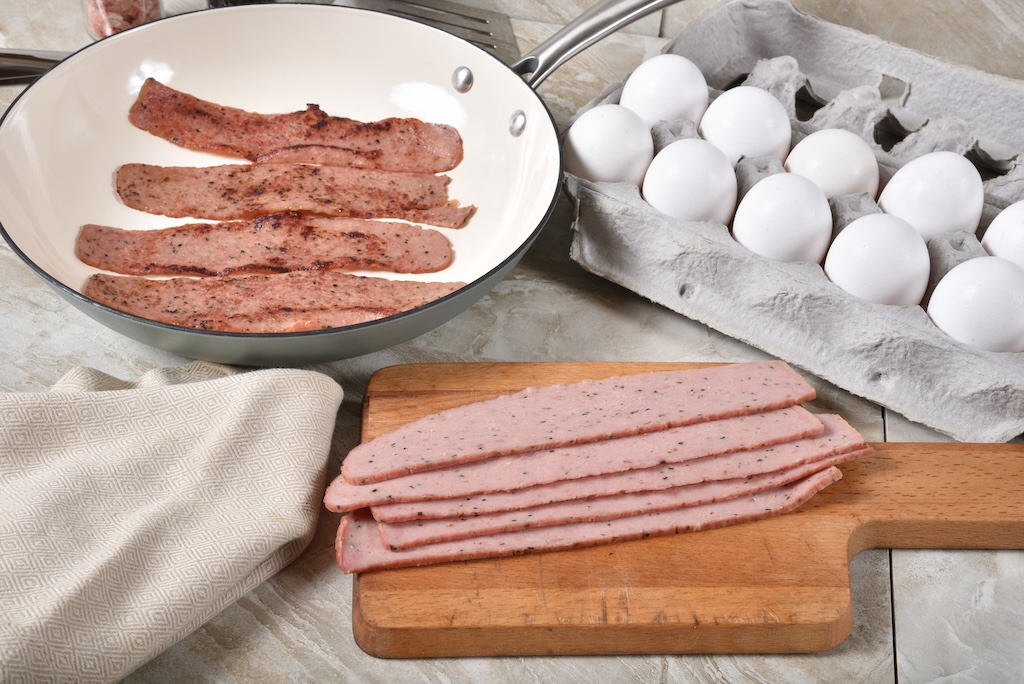
Cooking eggs and bacon might seem like second nature, but knowing how to cook turkey bacon may come so naturally. Turkey bacon is a delicious and versatile substitute for regular bacon; which means you can substitute turkey bacon in any recipe or dish you’d normally use pork bacon in. From a BLT sandwich to a hearty Cobb salad, or on its own as part of a high-protein breakfast meal, there are endless options on what you can do with turkey bacon. But first and foremost, master how to cook turkey bacon with ease using these four trustworthy methods.
Why use turkey bacon

Traditional pork bacon is quite high in fat, with 22 grams of fat per 2-ounce serving. On the other hand, turkey bacon contains only a fraction of the fat and calories, with only 14 grams of fat per 2-ounce serving. Switching to turkey bacon is a smart choice as part of a calorie-cut, low-fat, or high-protein diet.
With more protein and less fat per serving, turkey bacon makes a solid breakfast side dish or ingredient for lunches to help you achieve your weight loss goals too. When shopping for turkey bacon, look for “nitrite-free” (such as in Applegate Farms products) which means the meat does not contain a preservative known as sodium nitrite.
How to cook turkey bacon

Deciding how to cook turkey bacon ultimately depends on your personal preference, the tools available to you, how much time you have, and how you like to enjoy your turkey bacon. There’s no “right or wrong” way to cook turkey bacon, but it might take some experimentation until you find the method you like best. Below, explore 4 different methods to cook turkey bacon to perfection.
Air fryer method
Cooking turkey bacon in the air fryer is one of the simplest, mess-free methods for reliable, crunchy turkey bacon. This method will work whether you have an air fryer basket, tray, or a built-in air fryer feature as part of an oven. The air fryer method is fast and efficient, ideal for when you need a quick meal. To cook turkey bacon in the oven:
- Preheat your air fryer to 400 degrees.
- Line up turkey bacon side by side without overlapping pieces. For smaller air fryers, you may need to do two rounds to cook the desired amount of turkey bacon.
- Cook for 5 to 6 minutes at 400 degrees, flipping halfway.
- Remove and enjoy!
Note: Some air fryers are more powerful than others. If your air fryer is especially efficient, you may need to reduce the temperature slightly. Turkey bacon tends to be chewier than pork bacon, so you don’t want to overcook it!
Oven-baked method
If you don’t have an air fryer, turkey bacon can be cooked similarly in a standard oven. Cooking turkey bacon on a lined baking sheet requires minimal to no clean-up, making it an excellent option if you’re looking for a hassle-free method. To cook turkey bacon in the oven:
- Preheat your oven to 400 degrees.
- Line a baking sheet with parchment paper or aluminum foil.
- Lay turkey bacon flat, side by side without overlapping on the baking sheet.
- Cook for 15 to 20 minutes, depending on desired crispiness.
Pan/stove method
Cooking bacon on the stove in a standard pan is the most commonly used method (and probably the method your grandparents still use). This tried-and-true method allows you to have more control over the cooking process than the air-fryer or oven-baked methods. In turn, this ensures you’re left with that “just right” crispiness you’re looking for. However, this method does mean more clean-up than other methods and a more time-consuming process. To cook turkey bacon on the stove:
- Heat a non-stick skillet to medium heat.
- Arrange turkey bacon slices one by one, without overlapping.
- Cook for 2 to 3 minutes on each side, then flip and repeat for another 2 to 3 minutes on the other side.
- Drain the bacon and blot extra fat with a paper towel (optional).
- Enjoy!
Microwave method
If you’re really in a rush, you can also cook turkey bacon in the microwave. Ideal for those busy mornings, turkey bacon can be cooked in the microwave in just two minutes. Here’s how:
- Place turkey bacon slices in a single layer atop a paper towel and place on a microwave-safe plate.
- Microwave for two minutes. Some microwaves may require an additional minute to achieve the desired crispiness.
- Enjoy!
Note: Although this method is quick and easy, it might not be the best method if you prefer your turkey bacon to get extra crispy. For crispier turkey bacon, we recommend the air fryer method instead.



